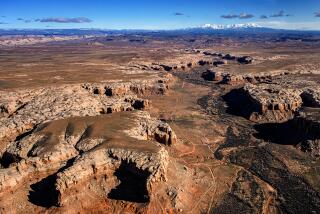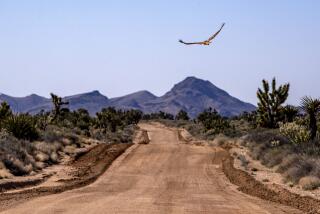Margaret ‘Mardy’ Murie, 101; Helped Create Arctic Refuge
- Share via
Margaret “Mardy” Murie, considered the matriarch of the modern conservation movement for her work on the 1964 Wilderness Act and in creating the Arctic National Wildlife Refuge, has died. She was 101.
Murie died Sunday of natural causes at her log cabin near Moose, Wyo., and Grand Teton National Park. She had been confined to a wheelchair in recent years, looked after by caretakers and wilderness movement acolytes who kept her cabin in order and her bills paid.
In 1998, President Clinton presented Murie with the Presidential Medal of Freedom, calling her “a pioneer of the environmental movement.” She also received an Audubon Medal in 1980 and the Sierra Club’s John Muir Award in 1981.
The Murie ranch became a center for the conservation and wilderness community in the 1940s, when Murie’s husband, wildlife biologist Olaus Murie, who died in 1963, established his office there as director of the Wilderness Society.
“There are a handful of people we count among our legendary heroes,” Bill Meadows, head of the Wilderness Society, said when Murie celebrated her 100th birthday last year. “Within the wilderness family, Mardy is still considered the matriarch.”
Murie had bequeathed her ranch, designated a national historic district, to the National Park Service, which long ago dubbed her an honorary ranger. Her legacy, and that of her husband, will continue in activities of the Murie Center, established on the ranch in 1997 to foster wilderness conservation advocacy.
The Wilderness Act, for which Murie and her husband sowed the seeds, banned development on millions of acres in national forests, parks and other land. She was present in the White House Rose Garden when President Lyndon B. Johnson signed the act in 1964.
Murie, who campaigned for her conservation causes as a self-described “emotional woman,” in the 1950s became interested in establishing an arctic refuge in Alaska, where she had grown up and met her husband.
She recruited the late Supreme Court Justice William O. Douglas to help persuade President Eisenhower to set aside 8 million acres for the refuge. The area was later expanded to 19 million acres and in 1980 was named the Arctic National Wildlife Refuge. The Alaska Lands Act signed by President Carter at that time preserved the refuge from oil and gas development.
“Beauty is a resource in and of itself,” Murie had testified for the Alaskan Lands Bill on June 5, 1977, at hearings in Denver. “Alaska must be allowed to be Alaska; that is her greatest economy. I hope the United States of America is not so rich that she can afford to let these wildernesses pass by -- or so poor she cannot afford to keep them.”
After passage was secured, Murie said, “I’m so grateful that much of Alaska has been saved.... Alaska is a non-ending savings account that goes on forever.”
Murie wrote three books about her life in the largest state: “Wapiti Wilderness” with her husband, “Two in the Far North” and “Island Between.”
Although she had always kept a journal, she wrote the books at the urging of a friend who was a Knopf editor, Murie told the Anchorage Daily News in 1997. “I just told our stories. My sense of wilderness is personal. It’s the experience of being in wilderness that matters, the feeling of a place.”
Born in Seattle in 1902, the former Mardy Gillette moved to Fairbanks, Alaska, at age 9, when she and her mother joined her stepfather there. In 1924, she became the first woman to graduate from the Alaska Agricultural College and School of Mines -- now the University of Alaska -- and a couple of months later married Olaus Murie.
They set off on a three-month honeymoon by dog-sled while he studied migrating caribou. She decided from the outset that she would accompany her husband on his field trips, even if it meant keeping house in a tent, cooking over campfires and traveling by canoe or snowshoe.
Asked whether rearing three children in the Alaskan and Wyoming wilderness had posed hardships, she said in a National Park Service oral history a few years ago: “My answer to that is, always to think of all the things I didn’t have to do, like go to bridge parties or answer the phone or wax the floor.”
The Muries moved to Jackson Hole, Wyo., in 1927, when her husband was assigned to study the dwindling herds of elk for the U.S. Biological Survey, now the U.S. Fish & Wildlife Service. They bought their 77-acre ranch in the shadow of the Grand Tetons in the mid-1940s and were credited with helping create Grand Teton National Park in 1929 and later expand it.
Mardy Murie served as her husband’s secretary, hostess and cook as well as forthright adjunct in his preservation activities. After his death, she became the speaker, addressing Congress, state and federal agencies, and conservation and environmental groups. She also became a mentor to young people who found their way to her cabin on the Snake River for tea, gingersnaps and conversation.
“One of her great contributions was to guide and inspire young people,” Bob Ekey, a Northern Rockies executive for the Wilderness Society, said after her death. “People in every state of the nation and probably every campaign that goes on to protect wild lands today was inspired, in some way, by her.”
Murie is survived by her three children, Martin, Joanne and Donald; a sister, Louise “Weezy” MacLeod; nine grandchildren, and 12 great-grandchildren.
More to Read
Sign up for Essential California
The most important California stories and recommendations in your inbox every morning.
You may occasionally receive promotional content from the Los Angeles Times.













